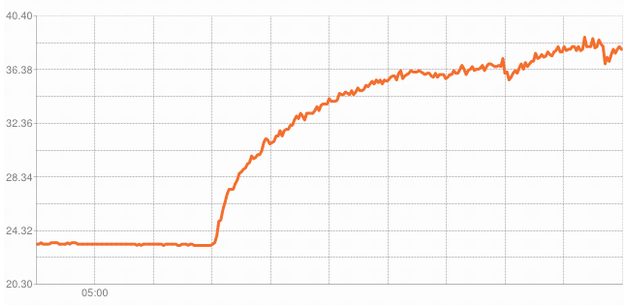My obituary will relate, I think, that I operated one of the Island’s leading humidity-monitoring-related websites. It’s a badge I will take to my death proudly. With that in mind, here’s the humidity rising in the Reinventorium this morning from 6:00 a.m. to 9:30 a.m. I have our Venta humidifier plugged into a WeMo Switch and a rule on the WeMo iOS app turns the switch on at 6:00 a.m.; this avoids running the humidifier all night, and ensures a pleasant office when we arrive 3 hours later.

As you can see from the graph (with each horizontal segment representing 30 minutes), things are pretty optimal by 7:30 a.m., so I can probably change the rule so that the humidifier turns on 90 minutes later and still find the office pleasant on arrival.
A note to those playing the home game, I’ve also updated the Python code that polls the Arduino to solve what I took to be an issue with the way I was reading the serial report (readings were, I think, being buffered because I was only polling the serial port every 30 seconds, resulting in herky-jerky data).
 I am
I am
Comments
I should let you do my thesis
I should let you do my thesis project for me. Time courses like that are what I’d collect by the dozen each time I did a recording experiment. The x-axis was milliseconds and not minutes, but to curve-fitting software and as they look on the screen, they are the same. What you’ve got there seems to be a simple exponential relaxation from one state to another following an effectively instantaneous change in conditions. I expect the time constant (time to 67% completion of the change) ought to be the reciprocal of humidifier’s water volume output per unit time (look up-able in its specs) times the volume of the room in the same units (such as liters for both volume parameters).
I suppose in a smaller room or more humid conditions in general, the time course of the relaxation would be more complicated. Approaching the dew point you get water condensing faster and faster until it matches the rate the humidifier is putting out, plus the rate at which the humidifier puts out vapor is going to decline precipitously (so to speak) short of the dew point, due to local condensation on its own parts (though you could allow it to get closer to dew point I suppose with a fan on it).
Oh, those are hours on your x
Oh, those are hours on your x-axis, not minutes. So if you swap hours for milliseconds (instead of minutes as I said above) then you have what my data looked like.
What’s you barometer?
What’s you barometer?
Drat. I meant “your”
Drat. I meant “your”
Actually, the time constant
Actually, the time constant won’t be what I said, because it would have to include as a component the rate at which vapor is exiting the room—which it must be, or the humidity would rise until close to the dew point.
Exiting the room and/or being
Exiting the room and/or being absorbed by the walls and absorbent things in room.
Add new comment